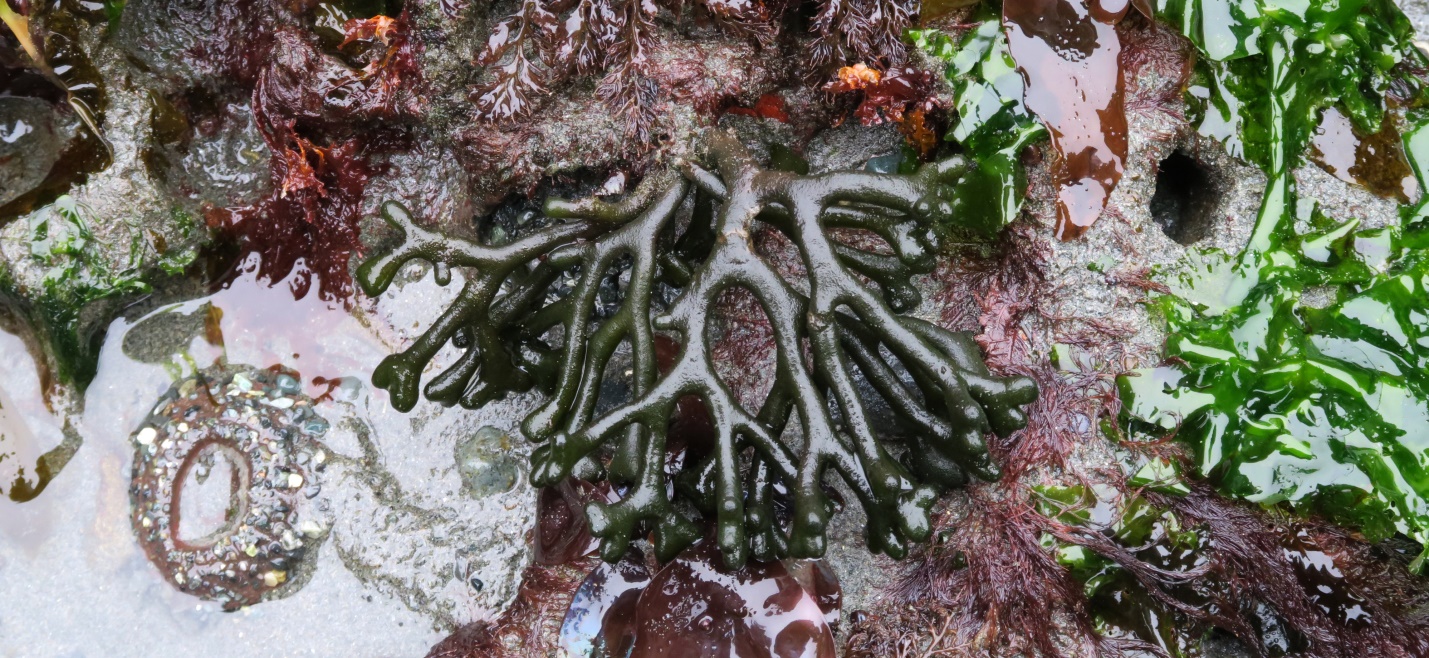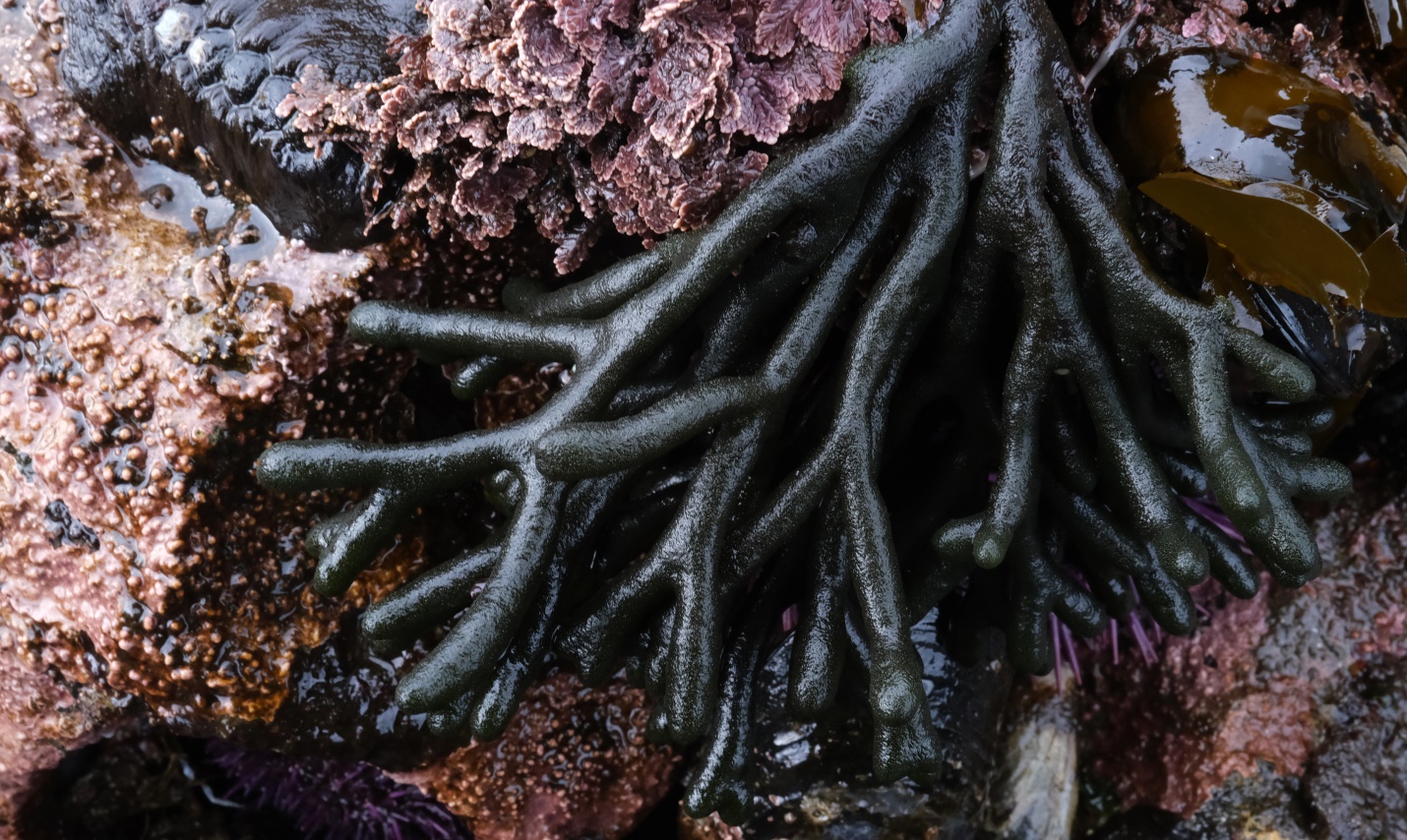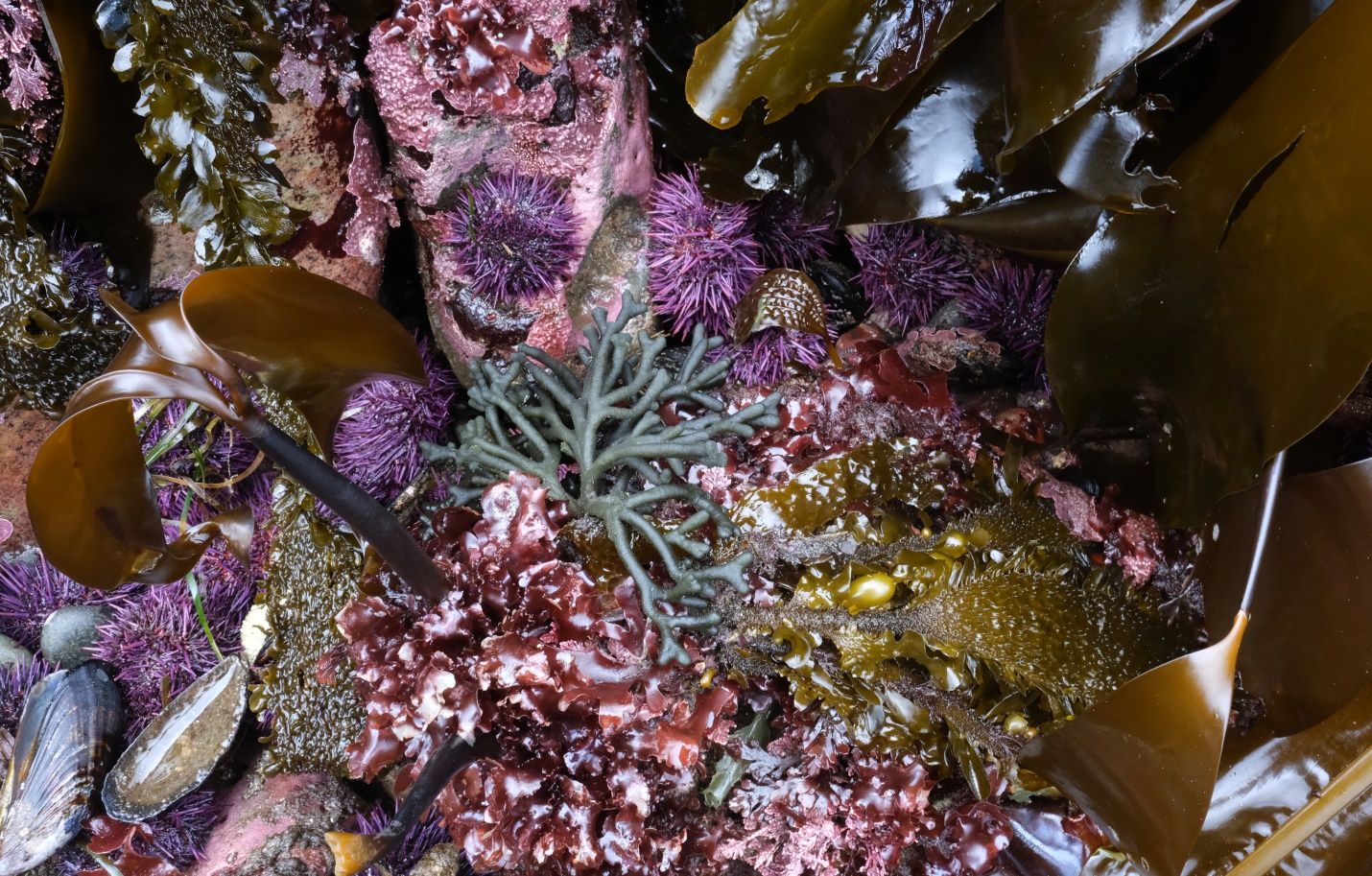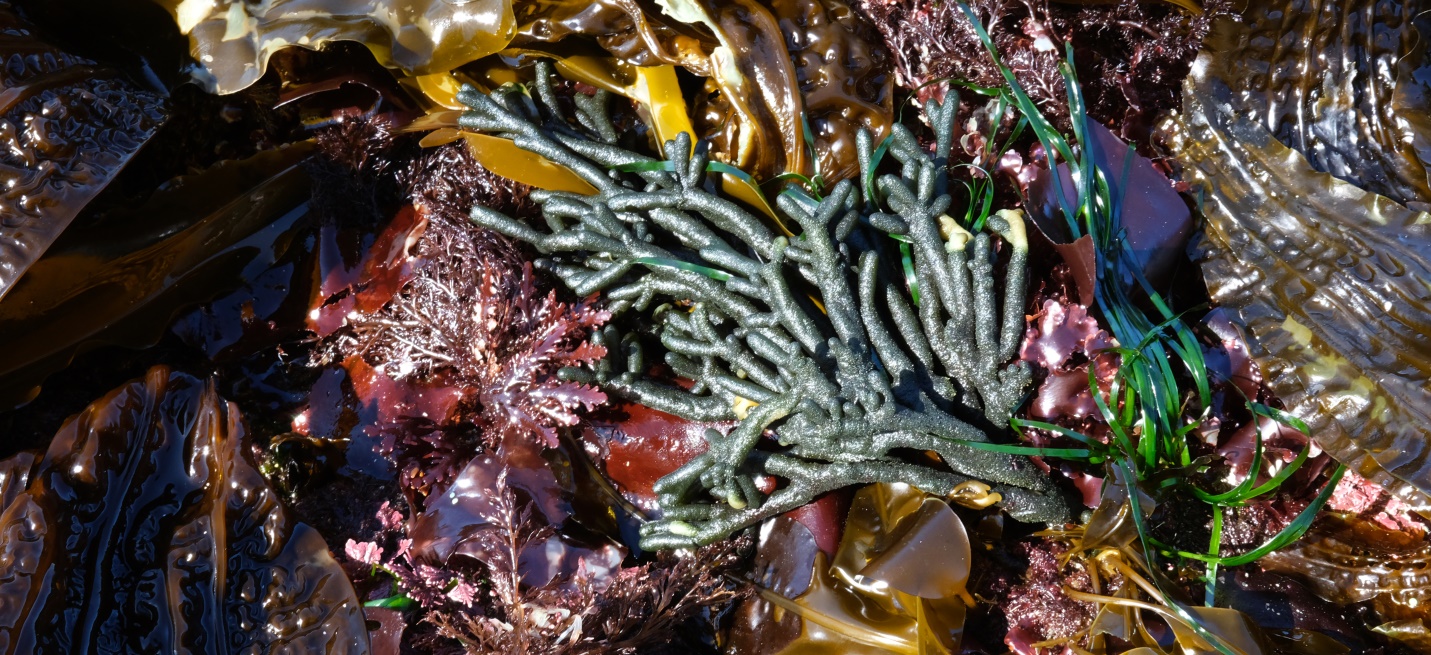
Codium fragile ssp. californicum
Sea Staghorn, Dead Man’s Fingers, Green Sponge-Fingers
On-site interactions: 26 February 2022
French Beach, Juan de Fuca Strait, B.C., Canada.
Tide: 1.3 feet at 5:27pm PST (measured at Sheringham Point Tidal Station)
Conditions: Low overcast, light rain, wind variable 5 to 10 km/hr, sea rippled, humidity 93%, 5˚C.
Moon: Waning Crescent (19%, day 26); Previous Phase, Third Quarter, 23 Feb 2022 at 2:32pm PST; Next Phase, New Moon, 2 Mar 2022 at 9:34am PST.
Note: we interacted with this seaweed on site, and due to the uncomfortable weather and time of day, we started compiling our notes the next morning at home.

Figure 1: Codium fragile ssp. californicum viewed underwater in its habitat with its colorful and diverse neighbors. French Beach, Juan de Fuca Strait, B.C., Canada. February 12, 2022. Photo ID 27312 ©Seaweedwhisperings.com
Person 1:
Clown, court jester.
Taunts, teases. Also easily engages in taunts and teases from others.
I’m engaging in playing with it, tossing it back and forth. It seems to flop around out of water.
Playful externally, but hiding seriousness beneath? Sadness?
Spongy to the feel.
Distinctive form – catches the eye, it’s so different.
Court jester – giving social statements through humor / satire or other means...

Figure 2: Codium fragile ssp. californicum exposed at low tide – it looks spongy and it is spongy; this seaweed takes quite a different form than its neighboring algae. French Beach, Juan de Fuca Strait, BC, Canada. February 26, 2022. Photo ID 27313 ©Seaweedwhisperings.com
Person 2:
Green – deep, dark green.
Spongy.
Roomy spacing to your branching.
Tips end in rounded forks.
Proportions are uniform though pattern of branching is not.
You do not collapse when out of water, but hold your form very well.
There is a texture to your surface, it is not quite smooth, but it is not rough, maybe finely porous.
You don’t look like many other seaweeds do.
You look more like a sponge – therefore an animal-plant. A hybrid? A wanna be?
I am compelled to play with your branches.
I squeeze gently and find that you have substance, you don’t compress much, and you easily bounce back.
Your look is almost cartoonish.
The rounded tips of your branches remind me of a common cartoon depiction of a dog’s bone.
I feel like you would be tirelessly playful, but that that one could grow bored with it; like your repertoire of ‘play’ is finite and doesn’t go beyond a certain type of expression.
That said, though, there is a genuine lightheartedness at your core; and that energy lingered with me long after I left you.
Underwater I watched your whole form flip back and forth with the surf, but there was no waving or wafting of your parts. Instead you moved ‘as a unit’ and as such, compared to many other macro algae, you appear a bit stiff and clumsy.
Why hold your form so stiffly? Are you frozen in place? Would movement harm you? Do you fear anything other than what you already know?
You are growing in the company of many other varied and colorful life forms. The rings of colored tentacles of the sea anemones, the lacy shapes of the Plocamium fronds, the gracefully wafting stems of Winged-rib, the fluffy, powder puffs of Pretty Polly clusters, the waving translucent bright green Ulva blades, the cobbles and pebbles and sand that make up the substrate – all combined, I had the impression of a cast of characters on stage for an intertidal play performance or a circus finale. And, you, Codium fragile, are one of the players, one of the talents on that stage.
But what are you representing? Not yourself. No, not at all. You have studied your role and you have become it – embodied it as if it was you.
Do you get lost to yourself? At times, I think this can happen.
How then to reacquaint with your own ‘self’ once again – by going back…, back through…, retracing your steps…, it feels like this can be like wandering in a maze. You can feel close, so close…, but then there is yet another boundary, a few more turns in the maze that continue to separate you from yourself.
I later looked up “maze” with google on the internet, and the first photo I saw there (of the Blenheim Palace maze in Great Britain) was so very much like Codium fragile – I laughed with recognition! Rounded, evenly sized, convoluted green barriers, spaced evenly and enclosing those who enter into the maze within a living puzzle.

Figure 3: The dichotomous branches and deep green color of Codium fragile ssp. californicum is unmistakable next to pink coralline algae and pieces of young kelp. With no water to “float” the buoyant thalli, this algae drops downward from its holdfast but the forks and branches retain their structure. Botany Bay, Strait of Juan de Fuca, B.C., Canada. May 17, 2022. Photo ID 27314 ©Seaweedwhisperings.com
Further Observations & Impressions:
Person 1:
Living in a fairytale world; such as Figure 1 (above), this looks more like painting, the colors and shapes and arrangement are presented almost artistically.
Blunt, not sharp, in form and words; fairly straightforward but guarded.
Indecisive; there’s a testing; I’ll put this idea out and wait for a reaction. Maybe putting out several ideas, but much time is spent indecisively waiting for external input.
Disconnect between appearance and actions; you’re looking / dressed in a distinct way but your actions don’t quite match that. Like if you’re doing a demonstration of how pioneers cooked and made bread in the late 1800’s in western USA, and then…, then they pop something into a microwave so you can have a sample. Often what is truly from bygone times cannot be reenacted in present times without present influences playing a part.
Person 2:
Codium fragile, it strikes me that you were very pleased that we had come back to ‘visit’ you again, especially on this inclement weather day. We’d only first found you two weeks ago and although we did marvel at finding you we didn’t focus on interacting with you then. I have read that your species can be ‘invasive’, growing in numbers and with such abundance that your presence is considered a detriment to other native species. But, here, in my region, I’ve had a hard time finding you at any location I’ve explored. And when we returned today, with a lower tide to give us more time for exploration, well even though I could look around a bit better, I still could only find you, the one individual representative of your kind.
Are you lonely? I think that can be true, with only yourself to interact with among the varied other species adjacent.
And that can become isolating, hence your delight in my return visit.
It is not common, one, that you get visitors, and two, that your visitors want to see you and understand you just as you are and for whom you are. You’ve noted my interest in you.
I will say I had a concern, also, that you may have been ‘picked’ by some curious beachcombing human and that we would not find you still growing here safe in the wild. Your form is distinctive enough, and you look like a creature that would ‘preserve’ well in a collection (like the fate of so many sea stars and sand dollars and dogwinkle, rocksnail, topsnail, moonsnail, turban and whelk snail shells). So, indeed, this was another reason I felt ‘delight’ to find you here once again.
Your branches are compared to human digits, to fingers, and indeed the endings of your branches, with their stubby forks, look somewhat like the ‘knuckle’ or the ‘ball’ ending where bones in a skeleton meet to form joints.
Is that a concept of note for your energy, too? Do you have something to do with the ‘end’ of something, where everything is bound up and finished off, and that ‘end’ is part of, yet not wholly identified with, a larger whole? You are limited to your ‘side’ of the joint, and can’t easily go beyond?
Knobby joint, but only half of the joint; or cut off and healed, as if someone has severed their finger. How it rounds off at the end reminds me of the ‘stump’ of a human limb, and also how some tree stumps heal over.
Maze, cut off, an end with no place further to go.
No resolution to an issue. Being cut off, the issue just can’t be resolved and there seems to be no place to go; stuck at a dead end. Ah, like “Dead” man’s fingers…, dead end. There’s something to that concept here.
Looking at the form of Codium fragile I am reminded of the Flintstones cartoon show I watched when I was a child.
Flintstones. Stone-age setting / characters.
Primitive? Or, throwback.
Yes, the term “throwback” is more accurate for the energy I perceive in this seaweed.
Throwback’s first set of definitions are:
One, that which is suggestive of or suited to an earlier time or style; a reversion to an earlier ancestral characteristic / type / phase; a person having the characteristics of a former time.
It also can mean, as a second definition: to delay the progress or advance of, to check; to cause to rely on / make dependent.
And as a third definition we have that throwback as an intransitive verb is a synonym of to ‘reflect’.
To reflect – like this seaweed is rubbery / spongy and just bounces back to shape. You interact with it and it’s playful, but it’s difficult to know what may be there deeper inside, what they’re made of – you just get the surfaced reflected back to you.
This concept, to reflect, has another set of interesting meanings:
To prevent passage of and change direction, i.e. a mirror reflects light
To give back or exhibit as an image, likeness or outline
To bring or cast as a result, i.e., his report reflects the decision of the board
To make manifest or apparent, to show; i.e., his piano composition reflects his profound sadness
To realize, consider
To bend or fold back
As an intransitive verb to reflect means:
To throw back light or sound
To think quietly and calmly
To express a thought or opinion resulting from reflection
And in a more proactive way, it can mean to have a bearing or influence.

Figure 4: It seems that Codium fragile ssp. californicum can often “take the stage” with quite the varied cast of characters – as this photo depicts. Botany Bay, Strait of Juan de Fuca, B.C., Canada. May 17, 2022. Photo ID 27315 ©Seaweedwhisperings.com
Discussion:
The ‘throwback’ concept is interesting – to be a living example of an earlier time / style / evolution. This would fit with certain jobs or hobbies in life, such as a collector of antique cars, or a curator of the local train museum, or a person who delights in wearing clothing and hairstyles from a particular era. These persons are nostalgic for times past and they dwell there more comfortably, or at least they see the value of those past times, and love to reflect key traits in current times.
Also, with the reversion to an earlier type or phase we saw in that the opportunity for a second chance, even genetically speaking, for that earlier type / phase to thrive and evolve. Originally the earlier type was bypassed, but a throwback could give another chance for that evolution to resume.
A ‘talent’ for such a person who is living in a balanced way with this energy is that they would be able to go back and to reflect upon an earlier time, be able to see perhaps “what went wrong” and therefore also know the point from which they might start over again. It is like, “Oh, that’s what I did wrong! Now I’ll try this way.” And the new ‘way’ is informed by the lessons of the previous.
The throwback possibly is a way to new inventiveness and new opportunities without having to completely destroy everything and go right back to the start – and expression for this is “don’t throw out the baby with the bathwater”. For example, we may see that discarded shoes made primarily of plastic (and similar compounds) are plugging up and fouling the ocean beaches and barrier reefs of the world. So we can wisely throw out the idea of plastic shoes, but the concept of shoes being valuable is retained; we throw back to the times of using leather and make them out of fibers that will decompose when they must finally be discarded.
The throwback concept also neatly reflects why Codium fragile was so pleased that we had RETURNED. Compared to other seaweeds that we interacted with on this same day, returning to see them because we knew we could also find them there, Codium was beaming in delight. Why? By our very action of coming back to this place at a later time, we were stepping into the energy of this seaweed, acting in a way that it does – reflecting and returning, stepping back, bringing back and throwing back; we were experiencing the usefulness and indeed particular value of this Codium trait.
Codium fragile also has the strong themes of being a ‘player on a stage’ and other artistic attributes. It seems as if the energy of this seaweed is one that can portray others very well and enjoys doing so. There is a component that is not quite obsessive to this trait, though; it is as if Codium can get lost in these performances, that they can become all-consuming and all-important and the efforts wind on and on, rather like one giant cell, not quite differentiating into another one.

Figure 5: A closer view of Codium fragile ssp. californicum reveals the ‘scaly’ or ‘felted’ texture to the surface of the cylindrical ‘stems’. French Beach, Juan de Fuca Strait, B.C., Canada. February 12, 2022. Photo ID 27316 ©Seaweedwhisperings.com
Biology & Natural History Information:
Description:
A deep green to blackish green thallus (10 to 40 cm tall) consisting of one to many dichotomously branched cylindrical segments. The spongy textured thallus has fuzzy or felted appearance that sets it apart from most other seaweeds. It arises from a cushiony basal disc which is this species style of holdfast and tubular branches are often about 6 mm in diameter though they can reach up to 1 cm. One distinctive fact is that the entire thallus of Codium fragile consists of interwoven and confluent filaments that lack cross-walls and are in fact a single multinucleate cell called a coenocyte.
Habitat:
This species grows on bedrock or boulders in the low intertidal and subtidal of semi-exposed or open coastlines.
Pacific Coast Distribution:
Sitka Alaska, on south to Bahia Asuncion, Baja California, Mexico. The species Codium fragile is found in many regions worldwide while the subspecies native to the region on the eastern edge of the Pacific, and the one we interacted with, is Codium fragile ssp. californicum.
Remarks:
Codium species consist of long cells, some measure up to 30 cm long (yes, a single cell of this seaweed can be 30 cm long); these cells branch near the alga’s surface and there they differentiate into a scale-like of felted-looking “skin” which can be viewed with a hand lens. Codium fragile had an unusual introduction to the Mediterranean. It was brought from California to the Banyuls-sur-Mer marine station for research purposes prior to World War II. Allied bombers ‘liberated’ Codium from the careful laboratory storage and it has persisted as an invasive species ever since. This seaweed is not popular with the shellfish industry of New England because the plant can foul nets and when attached to living shellfish can cause them to become too buoyant and float away. The subspecies C. fragile ssp. fragile (formerly ssp. tomentosoides) is native to the Pacific coastline of Asia and is invasive in many regions in the world where it is considered to be one of the most troublesome invasive species.
Classification:
Phylum: Chlorophyta
Class: Ulvophyceae
Order: Bryopsidales
Family: Codiaceae
Genus: Codium
Species: Codium fragile (Suringar) Hariot subsp. californicum (J.Agardh) Maggs & J.Kelly 2007

Figure 6: Another Codium individual, once again growing amidst a strong diversity of other macro algae. The spot where this seaweed is growing is a very open and exposed beach. The balance of life here seems healthy and Codium is not behaving like an ‘invasive’ but more like a rather distinctive species to encounter. Botany Bay, Strait of Juan de Fuca, B.C., Canada. May 20, 2022. Photo ID 27317 ©Seaweedwhisperings.com
![]()